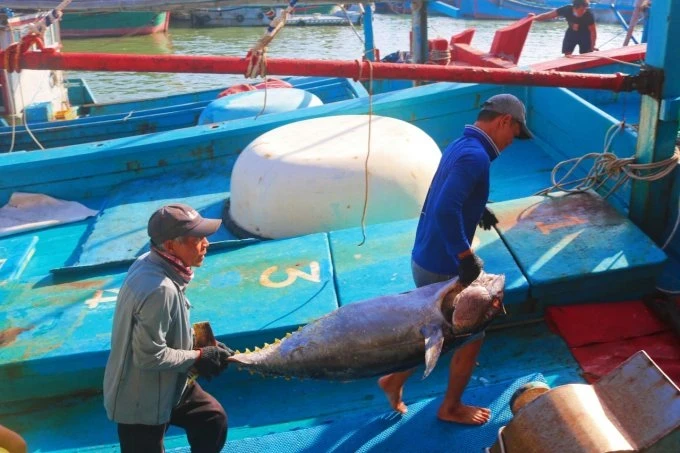
Returning from a 20-day fishing expedition in the Spratly Islands, 56-year-old fisherman Nguyen Nhon from Quang Ngai Province expressed deep concern over the plummeting prices of skipjack tuna. He noted that the price per kilogram had halved from a peak of VND30,000 (US$1.22) a kilo, a substantial decline that threatens the livelihoods of many fishermen since it normally costs VND140 million ($5,700) per fishing round.
Similar sentiments were echoed by Nguyen Van Su from Hoai Nhon Town of Binh Dinh Province, whose recent catch of 30 tonnes of skipjack tuna fetched only half of the previous market price of VND900 million ($36,600). In this coastal town, a significant fishing hub, numerous vessels have incurred substantial losses due to this recent tuna price crash.
Vu Thanh Hoang, another local fisherman in Hoai Nhon Town owning a fleet of five vessels with a combined 3,000 horsepower and 71 crew members, is among those deeply affected. The calamitous fall in seafood prices has left him and his fellow fishermen in a state of despair, as processing companies have threatened to cease their purchases.
“Many vessels here are incurring losses of between VND100 - 200 million ($4,050 – 8,100) per voyage,” Mr. Hoang lamented, “and most fishermen are barely surviving. My fleet alone requires over VND1 billion ($40,500) for each expedition. If this continues, bankruptcy is imminent.”
The Vietnam Fisheries Society (VINAFIS) has petitioned the Ministry of Agriculture and Rural Development to address this pressing issue. VINAFIS argues that the size restrictions imposed by Decree 37/2024/ND-CP (issued on April 4, 2024 about amending a number of provisions of Decree 26/2019/ND-CP) are impractical, given the biological characteristics of the tuna species in Vietnamese waters.
Research conducted by the Research Institute for Marine Fisheries (under the Ministry of Agriculture and Rural Development) in 2020 indicates that the majority of skipjack tuna caught in the country are Katsuwwonus pelamis with a length of 18-50cm, which falls below the mandated size limit. Also, the Western and Central Pacific Fisheries Commission (WCPFC) commented that the supply of skipjack tuna in Vietnam is quite rich, and its exploitation is within the limit.
The Vietnam Tuna Association has highlighted that skipjack tuna, ranging from 20-40cm and weighing between 0.5kg and 3.5kg, are currently being purchased by canning companies at ports across the South Central Coast and Mekong Delta regions.
However, under the stipulations of Appendix V of Decree 37, any skipjack tuna harvested, purchased, certified, or exported below 50 cm is considered a violation. Consequently, regulatory authorities have been unable to verify or issue export certificates for these smaller fish.
Director Nguyen Van Muoi of the Quang Ngai Provincial Fisheries Department asserted that importing countries have not imposed stringent size requirements for Vietnamese tuna. Therefore, excessively high standards would be counterproductive, causing undue hardship for fishermen and businesses, and ultimately harming the nation's overall tuna exports.
Director Nguyen Huu Nghia of the Binh Dinh Provincial Fisheries Department this Appendix impacts not only skipjack tuna but also yellowfin tuna and other oceanic tuna species.
“According to the Vietnam Directorate of Fisheries,” Mr. Nghia stated, “this regulation was proposed by the Vietnam Fisheries Surveillance. At the local level, although the Vietnam Fisheries Surveillance conducted surveys and sought input, the provinces were preoccupied with combating IUU fishing and thus overlooked the potential issues arising from these new regulations.”
Deputy Director Le Tran Nguyen Hung of the Vietnam Fisheries Surveillance (under the Ministry of Agriculture and Rural Development) disclosed that a survey revealed an alarming decline in Vietnam's fishery resources, from 5.07 million tonnes between 2000 and 2005 to 3.95 million tonnes between 2016 and 2020, representing a 22.1-percent decrease.
The primary cause is attributed to overfishing, particularly the exploitation of juvenile fish. Hung emphasized that if this trend continues unchecked, the nation's fish stocks will be depleted within a few years.
Deputy Director Hung also provided scientific justifications for the minimum size regulations, noting that many other organizations and countries have implemented similar measures. Moreover, Decree 37 allows for a 15-percent tolerance for fish below the specified size, facilitating practical implementation.
To address the concerns raised by the industry, he announced that his organization will convene a meeting with researchers, policymakers, the Vietnam Association of Seafood Exporters and Producers (VASEP), businesses, and fishermen to solicit feedback and develop recommendations for the Ministry of Agriculture and Rural Development and the Prime Minister.
The goal is to strike a balance between sustainable fishery resource management and the economic interests of fishing communities while complying with international standards and promoting integration.
























